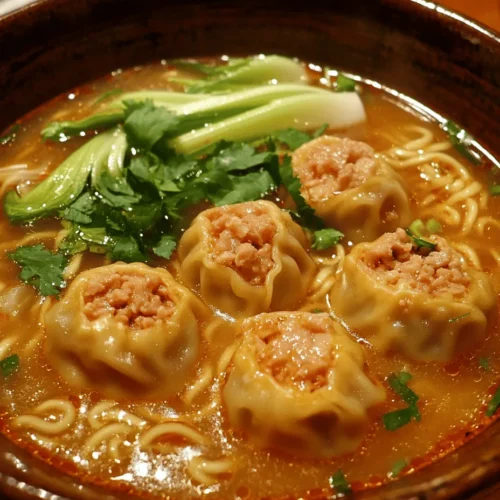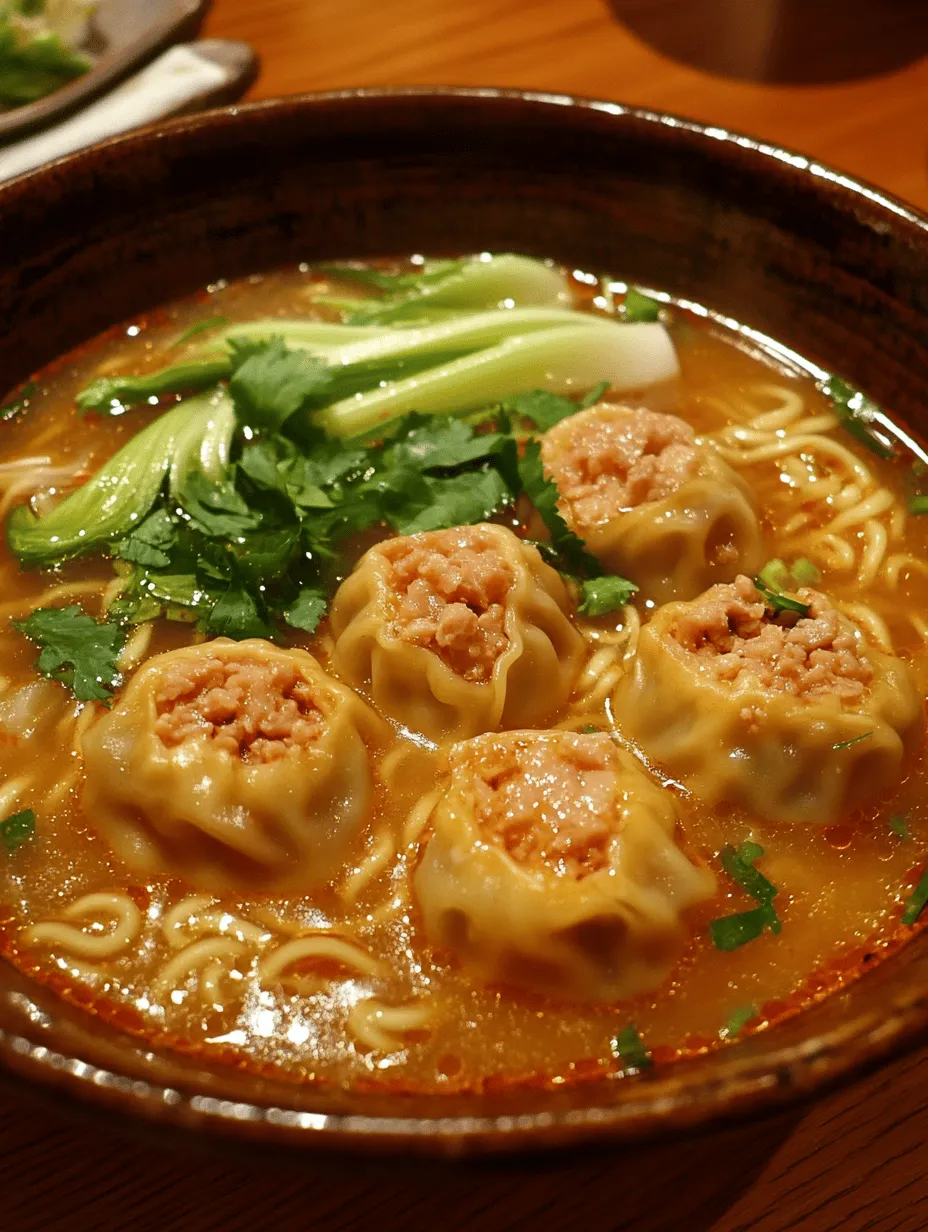Introduction
Wonton noodle soup is a quintessential dish in Asian cuisine, celebrated for its rich flavors and comforting qualities. This warm, hearty soup is a staple in many households, particularly during cooler weather, yet it remains a favorite regardless of the season. The combination of tender wontons, flavorful broth, and perfectly cooked noodles creates a dish that is both satisfying and nourishing. Making wonton noodle soup at home not only enhances the flavors but also allows you to control the ingredients, ensuring a nutritious meal that aligns with your dietary preferences.
As you embark on the journey of creating this cozy homemade wonton noodle soup, you’ll find that every step—from crafting the delicate wontons to simmering the savory broth—adds a personal touch to this beloved dish. The process can be therapeutic, transforming simple ingredients into a comforting bowl of goodness that warms the heart and soul.
Understanding Wonton Noodle Soup
Wonton noodle soup has a rich history that traces back to the southern regions of China, particularly Guangdong province. It is believed that the dish emerged in the late 19th century, evolving from street food to a beloved restaurant dish that symbolizes comfort and home. The word “wonton” translates to “swallowing clouds,” aptly describing the delicate dumplings that float in the savory broth.
This dish reflects the diverse culinary traditions of Asia, with each region boasting its own variations. In Hong Kong, for instance, wonton noodle soup is characterized by thin egg noodles and a light, flavorful broth that allows the wontons to shine. Meanwhile, in Taiwan, the soup may feature thicker noodles and additional toppings such as greens or fried shallots. Each variation showcases local ingredients and culinary techniques, adding depth to the dish’s cultural relevance.
A traditional wonton noodle soup consists of three main components: the wontons, the broth, and the noodles. The wontons, filled with a savory mixture of meat and seafood, are the star of the dish. The broth, usually a clear chicken or pork-based stock, provides a warm, savory backdrop for the wontons and noodles. Finally, the egg noodles add a satisfying texture that complements the soup’s overall flavor profile. Together, these elements create a harmonious dish that is both nourishing and comforting.
Key Ingredients for the Wontons
The wontons are the heart of this noodle soup, and the quality of their filling plays a crucial role in the overall taste. Here are the primary ingredients that make up the wonton filling:
– Ground Pork (or Chicken): The primary protein in the wontons, ground pork is favored for its rich flavor and succulent texture. It is a source of essential nutrients, providing protein, iron, and B vitamins. When cooked, the fat in the pork helps keep the filling moist and tender. For those seeking a lighter option, ground chicken can be used as a substitute.
– Finely Chopped Shrimp: Adding finely chopped shrimp to the filling enhances both the texture and taste of the wontons. Shrimp brings a subtle sweetness and a slight crunch, creating a delightful contrast with the tender pork. It also elevates the dish’s umami flavor, making the wontons more complex and satisfying.
– Aromatics (Green Onions, Garlic, Ginger): Aromatics are essential in Asian cooking, and they play a significant role in flavoring the wonton filling. Finely chopped green onions add a fresh, mild onion flavor, while minced garlic and ginger contribute warmth and depth. Together, these ingredients create a fragrant base that elevates the overall taste of the wontons.
– Soy Sauce and Sesame Oil: These two ingredients are staples in Asian cuisine and are critical for adding umami and richness to the wonton filling. Soy sauce provides a savory depth, while a drizzle of sesame oil imparts a nutty aroma that enhances the overall flavor profile. Together, they ensure that each wonton is bursting with flavor.
– Wonton Wrappers: The wrappers are equally important in creating the perfect wonton. They can be found in most Asian grocery stores, typically made from a simple mixture of flour, water, and salt. It’s crucial to choose high-quality wonton wrappers that are thin yet sturdy enough to hold the filling without tearing. Fresh or frozen options are available, making them accessible for home cooks.
Broth: The Heart of the Soup
The broth serves as the foundation of wonton noodle soup, infusing the dish with flavor and warmth. A well-crafted broth can elevate the entire experience, making it essential to pay attention to the ingredients that enhance its taste.
– Chicken Broth: The base of the soup is typically made from chicken broth, which provides a light yet flavorful foundation. Homemade broth is recommended, as it allows for greater control over the flavor and richness. Use chicken bones or carcasses, along with aromatics like onions, ginger, and garlic, simmered for hours to extract maximum flavor. If time is short, store-bought broth can be a convenient alternative, but opt for low-sodium versions to better control the soup’s seasoning.
– Flavor-Enhancing Ingredients: Several ingredients are commonly added to the broth to deepen its flavor. Soy sauce and oyster sauce are essential for adding umami, while a splash of vinegar brightens the overall taste. Five-spice powder, a blend of star anise, cloves, Chinese cinnamon, Sichuan peppercorns, and fennel seeds, adds an aromatic complexity that is characteristic of many Asian dishes. Balancing these ingredients is crucial, and tasting the broth as you go will help ensure a harmonious flavor.
– Seasoning and Tasting: As with any good broth, seasoning is key. It’s important to taste the broth throughout the cooking process, adjusting with additional soy sauce, salt, or vinegar as necessary. This will help achieve the perfect balance of flavors, ensuring that the broth complements the wontons and noodles beautifully.
Cooking the Noodles
Egg noodles are a vital component of wonton noodle soup, contributing both texture and flavor to the dish. The key to achieving the perfect noodle lies in how they are cooked.
– Importance of Egg Noodles: The texture of egg noodles is ideal for this soup, as they are slightly chewy and absorb the broth’s flavors well. Their richness contrasts beautifully with the lighter wontons and broth, creating a satisfying mouthfeel.
– Cooking Egg Noodles to Perfection: To prepare the egg noodles, follow the package instructions closely, as cooking times may vary depending on the brand and thickness of the noodles. Generally, bring a large pot of salted water to a rolling boil. Add the noodles and cook until they are just al dente—typically a minute or two less than the recommended cooking time. Overcooking can lead to mushy noodles that lose their structure. Once cooked, drain the noodles and rinse them under cold water to stop the cooking process and prevent sticking.
Preparing the Wontons: A Step-by-Step Guide
Now that you have a solid understanding of the ingredients and components of wonton noodle soup, it’s time to dive into the details of making the wontons from scratch. The process can be broken down into several simple steps, ensuring that even novice cooks can master this delicious dish.
1. Prepare the Filling: In a large mixing bowl, combine the ground pork (or chicken), finely chopped shrimp, green onions, minced garlic, minced ginger, soy sauce, and sesame oil. Mix until all ingredients are well incorporated. For a more intense flavor, consider letting the mixture marinate for about 30 minutes in the refrigerator.
2. Assemble the Wontons: Lay out a clean, flat surface to work on. Take a wonton wrapper and place about a teaspoon of the filling in the center. Moisten the edges of the wrapper with a little water. Fold the wrapper in half diagonally to form a triangle, pressing out any air as you seal the edges. For a more decorative shape, you can bring the two corners of the triangle together and pinch them to create a traditional wonton shape.
3. Repeat the Process: Continue assembling the wontons, placing them on a baking sheet lined with parchment paper to prevent sticking. If you’re making a large batch, consider freezing some for later use. To freeze, lay the wontons in a single layer on a baking sheet until solid, then transfer them to a sealed freezer bag.
4. Cook the Wontons: To cook the wontons, bring a large pot of water to a boil. Gently add the wontons and cook for about 4-6 minutes, or until they float to the surface and are cooked through. Use a slotted spoon to remove them and transfer them to a bowl or directly into the serving bowls with the broth.
With these steps, you’re well on your way to creating a delicious bowl of cozy homemade wonton noodle soup. The combination of tender wontons, savory broth, and perfectly cooked noodles is sure to become a favorite in your household, offering comfort and satisfaction in every spoonful.

Mixing the Filling Ingredients
To create the perfect wonton filling for your Cozy Homemade Wonton Noodle Soup, gather the following ingredients: ground pork, shrimp, ginger, garlic, soy sauce, sesame oil, and green onions. Start by placing the ground pork in a large mixing bowl. If you’re using shrimp, ensure they are peeled and deveined, then chop them finely or pulse them in a food processor until they reach a coarse texture.
Add 2-3 cloves of minced garlic and a tablespoon of grated ginger to the meat mixture. These aromatics will infuse your wontons with a fragrant flavor. Next, drizzle in a tablespoon of soy sauce and a teaspoon of sesame oil, which will enhance the umami taste of the filling. Finally, finely chop a couple of green onions and fold them into the mixture.
Use your hands or a spatula to mix the ingredients thoroughly, ensuring that the flavors meld together. This filling should be slightly sticky but not overly wet. If it seems too loose, consider adding a small amount of cornstarch to help bind it together. Once combined, cover the bowl with plastic wrap and let it rest in the refrigerator while you prepare the wonton wrappers.
Wrapping Techniques
The art of folding wontons is a crucial skill that can enhance both the presentation and integrity of your soup. Begin by laying out your wonton wrappers on a clean, dry surface. Keep a small bowl of water nearby; this will be your sealing agent.
Take one wrapper and place about a teaspoon of filling in the center. Using your finger, moisten the edges of the wrapper with water to ensure a good seal. For a classic pleated wonton, fold the wrapper in half to form a triangle. Pinch the edges to seal, making sure to remove any air pockets.
Next, take the two corners of the triangle and bring them together, overlapping them slightly. Pinch the corners together firmly to secure the shape. Your wonton should now resemble a small purse or pouch. For a more straightforward shape, simply fold the wrapper in half and seal the edges.
Tips for sealing wontons effectively include ensuring that you don’t overfill them, as this can lead to bursting during cooking. Additionally, make sure to expel all air pockets when sealing, as trapped air can also cause leaks. Once you’ve wrapped all your wontons, place them on a parchment-lined tray, making sure they are not touching to prevent sticking.
Cooking the Wontons in Broth
Cooking the wontons in broth is where the magic happens, transforming your fillings into tender, flavorful morsels. Begin by bringing a large pot of chicken or vegetable broth to a gentle simmer over medium heat. Avoid boiling, as a rapid boil can break apart the delicate wontons.
Carefully add the wontons to the simmering broth, ensuring they have enough space to float freely. Gently stir to prevent them from sticking to the bottom of the pot. It’s crucial to simmer the wontons rather than boil them, as this allows for proper cooking and flavor absorption from the broth.
You’ll know the wontons are done when they float to the surface, which typically takes about 5-7 minutes. This visual cue indicates that they are cooked through and ready to be enjoyed. Once they begin to float, you can take one out to test for doneness; the filling should be opaque, and the wrapper should be tender yet firm.
Final Assembly: Bringing It All Together
Once your wontons are cooked, it’s time to assemble your Cozy Homemade Wonton Noodle Soup. Start by preparing your noodles according to the package instructions. Fresh egg noodles are ideal for this recipe, but you can also use dried ones if necessary.
In each serving bowl, place a generous portion of cooked noodles. Next, add the cooked wontons on top. Carefully ladle the hot broth over the noodles and wontons, ensuring that each bowl receives an ample amount of flavorful broth.
To enhance the freshness and nutritional content of your soup, add a handful of bok choy to each bowl. The bok choy should be briefly blanched in the broth for about a minute before serving to maintain its vibrant color and crisp texture.
For garnish, finely chop some spring onions and fresh cilantro, scattering them over the top of each bowl. These herbs add a burst of flavor and a beautiful presentation. If you enjoy a bit of heat, consider drizzling some chili oil over the soup before serving, adding a delightful kick to your comforting bowl of wonton noodle soup.
Nutritional Benefits of Wonton Noodle Soup
Wonton noodle soup is not only delicious but also packed with nutritional benefits. The primary protein sources in this dish are pork and shrimp, both of which provide essential amino acids necessary for muscle repair and overall health. Shrimp is low in calories but high in protein, making it an excellent choice for those watching their weight.
The addition of bok choy contributes a range of vitamins and minerals, including vitamin C, vitamin K, and calcium. This leafy green is also rich in antioxidants, supporting your immune system and overall health. The aromatics used in the filling, such as garlic and ginger, are known for their anti-inflammatory properties and can aid digestion.
This soup provides a balanced profile of carbohydrates from the noodles, proteins from the meat and shrimp, and vitamins from the vegetables, making it a wholesome meal option. Each bowl serves as a comforting yet nutritious choice, perfect for cozy nights or when you need a little pick-me-up.
Variations and Customizations
One of the beautiful aspects of wonton noodle soup is its versatility. If you prefer alternative proteins, consider using ground chicken or turkey in place of pork. For a vegetarian option, you can make a filling using finely chopped mushrooms, tofu, and vegetables. Seafood variations can also be delightful, incorporating fish or even crab meat for a luxurious twist.
Feel free to customize the broth as well; if you like a spicier kick, add some chili paste or sriracha to the broth during cooking. Substitutions for ingredients can be made based on availability or personal preferences. For example, if bok choy is not available, napa cabbage or spinach can also work beautifully.
To elevate your soup further, consider additional toppings such as sliced radishes, fried garlic, or toasted sesame seeds. These small additions can enhance both the flavor and texture of your soup, making each bowl unique to your taste.
Conclusion
Homemade wonton noodle soup is a heartwarming dish that brings comfort and joy to any meal. The process of creating this traditional recipe from scratch allows you to explore your culinary skills and savor the rich flavors of its ingredients. From mixing the filling to the final assembly, each step is infused with love and care, resulting in a dish that not only nourishes the body but also warms the soul.
By making your own wontons and broth, you gain control over the flavors and ingredients, ensuring a fresh and satisfying experience. So, roll up your sleeves, gather your ingredients, and embark on this delightful culinary journey. Enjoy the warmth and comfort of your Cozy Homemade Wonton Noodle Soup, and share the joy of this delicious dish with family and friends.


